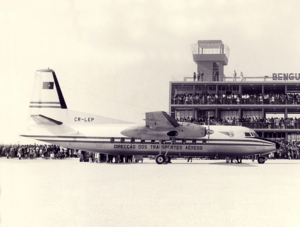TAAG Angola Airlines facts for kids

TAAG Angola Airlines 777-200ER in standard livery
|
|
| Founded | September 1938 (as DTA, Divisão dos Transportes Aéreos) |
|---|---|
| Commenced operations | 17 July 1940 |
| Hubs |
|
| Frequent-flyer program | Umbi Umbi Club |
| Subsidiaries |
|
| Fleet size | 26 |
| Destinations | 31 |
| Parent company | Government of Angola (100%) |
| Headquarters | Luanda, Angola |
| Key people | |
| Profit | |
| Employees | 3,268 |
TAAG Angola Airlines is an airline owned by the government of Angola. It is the main airline of the country. Based in Luanda, TAAG flies to places within Angola, across Africa, and to countries like Brazil, Cuba, and Portugal.
The airline started in 1938 as DTA – Divisão dos Transportes Aéreos. It changed its name to TAAG Angola Airlines in 1973. In 1975, it became Angola's official national airline. TAAG is a member of important airline groups like the International Air Transport Association. Its main airport is Quatro de Fevereiro Airport, but it is moving its operations to the new Dr. Antonio Agostinho Neto International Airport. The first flights from the new airport began on November 10, 2024.
Contents
History of TAAG Angola Airlines
Early Days: DTA (1938–1973)
The idea for an airline in Angola began in 1937. In September 1938, DTA – Divisão dos Transportes Aéreos was officially created. It was run by the government.
Flights started on July 17, 1940, using small De Havilland Dragon Rapide planes. The first routes connected Luanda to places like Pointe Noire and Benguela. Flights sometimes stopped during World War II because it was hard to get airplane parts. After the war, the airline started flying again.
In 1946, DC-3 and Beechcraft Model 18 planes joined the fleet. DTA became part of the International Air Transport Association in 1951. By April 1960, DTA had a fleet of Beech 18s, DC-3s, and DH.89s. In 1961, DTA ordered Fokker F-27 planes, which arrived in 1962. These new planes helped the airline expand its routes.
TAAG Angola Airlines Takes Off (1973–)
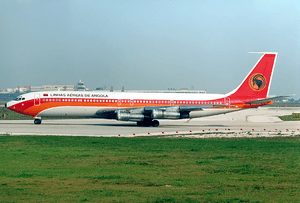
On October 1, 1973, the airline changed its name to TAAG – Transportes Aéreos de Angola. The Angolan government owned most of the company. In 1974, TAAG ordered four Boeing 737-200 planes. A new look for the planes, featuring the Sable antelope, was also introduced.
When Angola became independent from Portugal in 1975, TAAG became the country's national airline. In November 1975, TAAG received its first Boeing 737-200. More planes, including Boeing 707-320Cs and Yak-40s, joined the fleet in the late 1970s.
By March 1980, TAAG flew to many cities in Angola and internationally to places like Lisbon, Moscow, and Paris. The airline faced some challenges, including plane accidents. For example, a Boeing 737-200 crashed in 1983, resulting in many deaths. In the mid-1980s, TAAG added Ilyushin Il-62M planes for flights to Cuba.
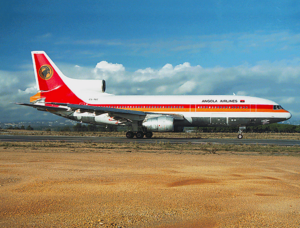
In March 1990, TAAG had a large fleet including Boeing 707s, 737s, and Fokker F.27s. It flew to 18 cities in Angola and many international destinations. In 1997, TAAG bought a Boeing 747-300 Combi plane.
In July 2005, TAAG ordered new Boeing 777-200ERs and Boeing 737-700s to replace older planes. These new aircraft started arriving in November 2006. One Boeing 777-200ER set a record by flying 12,860 kilometers (about 7,990 miles) non-stop from Seattle to Luanda. In March 2011, the Boeing 747-300 fleet was retired. In June 2011, TAAG became the first African airline to buy and fly the Boeing 777-300ER.
European Union Flight Restrictions (2007-2019)
In July 2007, the European Union (EU) stopped TAAG planes from flying into Europe due to safety concerns. This meant TAAG lost a lot of money. To keep flying to Europe, TAAG had to rent a Boeing 747-400 from South African Airways.
In November 2008, new leaders were appointed for TAAG to help fix the problems and get off the EU's restricted list. In May 2009, TAAG passed important safety checks. By July 2009, TAAG was allowed to fly to Portugal using only its three Boeing 777s. This was a big step forward.
In November 2009, the EU also allowed TAAG's four Boeing 737-700s to fly to Europe. By March 2010, TAAG could fly its Boeing 777-200ERs and 737-700s to all European airports. The ban was slowly lifted over the years. Finally, on April 17, 2019, the EU completely lifted the ban, allowing all TAAG aircraft to fly to any EU country.
Recent Growth and Future Plans
After the COVID-19 pandemic caused flights to stop, TAAG started flying again in September 2020. They used new De Havilland Canada Dash 8 planes for domestic flights. For longer flights, they continued to use their Boeing 777s.
In 2023, TAAG ordered 15 Airbus A220 planes to replace their Boeing 737-700s and expand their regional flights. They also ordered four Boeing 787 planes, making TAAG the first African airline to operate the larger 787-10 model.
In April 2023, TAAG partnered with a Brazilian airline, Gol Linhas Aéreas, to offer more connections for passengers. In May 2023, TAAG announced it had made a profit of about US$800,000 in the previous year.
The year 2024 marked a new chapter as TAAG began using the new Dr. Antonio Agostinho Neto International Airport in February for cargo flights. This new airport, which cost over $3 billion, is now TAAG's main hub for both passengers and cargo. The first passenger flights from the new airport started on November 10, 2024. TAAG also added new cargo planes, including a Boeing 737-800BCF and a large Boeing 747-400F, to boost its successful cargo business.
In September 2024, TAAG received its first Airbus A220. The airline plans to double its fleet to more than 40 aircraft in the coming years.
How TAAG is Organized
Ownership and Leadership
TAAG Angola Airlines is fully owned by the government of Angola. TAAG also owns another company called Angola Air Charter, which handles cargo flights in Africa.
As of October 2023, Eduardo Fairen is the Chief Executive Officer (CEO) of TAAG. Vipula Gunatilleka is the Chief Financial Officer (CFO).
Business Information
TAAG's business has changed over the years. For example, in 2008, the airline lost about $70 million. However, by 2016, the losses were much smaller, around $5 million.
The number of employees has also changed. In 2009, there were over 4,000 employees, but by 2022, this number was around 2,742. The number of passengers carried by TAAG has varied, reaching about 1.5 million in 2018 and 2019, and then recovering to 0.9 million in 2022 after the pandemic.
Main Office
TAAG's main office is in Luanda, Angola. The airline also has offices in other parts of Africa, Asia, Europe, and North and South America. In 2010, they opened an office in Beijing, China.
Where TAAG Flies
As of October 2014, TAAG Angola Airlines flies to 31 places. This includes 13 cities within Angola, 11 cities in Africa, three in Latin America, two in Europe, and three in the Middle East and Asia-Pacific regions.
Airline Partnerships
TAAG Angola Airlines works with other airlines through "codeshare agreements." This means they share flights, allowing passengers to connect more easily to different destinations. TAAG has partnerships with airlines like:
- Air France
- British Airways
- Brussels Airlines
- Gol Linhas Aereas
- Iberia
- Kenya Airways
- KLM
- LAM Mozambique Airlines
- Lufthansa
- Royal Air Maroc
- South African Airways
TAAG's Airplanes
Current Fleet
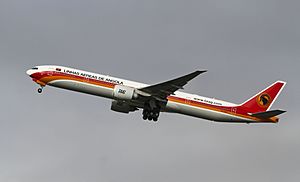
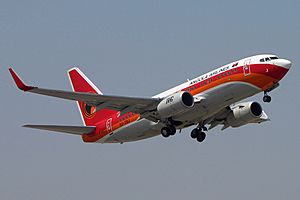
As of March 2025, TAAG flies the following types of airplanes:
- Airbus A220-300: 3 in service, 12 on order. These are replacing the Boeing 737-700s.
- Boeing 737-700: 7 in service. These planes will be retired soon.
- Boeing 777-200ER: 3 in service.
- Boeing 777-300ER: 5 in service.
- Boeing 787-9: 1 in service, 1 on order.
- Boeing 787-10: 0 in service, 2 on order.
- De Havilland Dash 8-400: 6 in service.
TAAG also has cargo planes:
- Boeing 737-700QC: 1 in service.
- Boeing 737-800BCF: 1 in service.
In total, TAAG has 27 planes in service and 15 on order.
Past Airplanes
Over the years, TAAG has used many different types of airplanes, including:
- Airbus A340-300
- Antonov An-26
- Boeing 707 (different models)
- Boeing 727
- Boeing 737-200 (different models)
- Boeing 747 (different models)
- Douglas C-47A
- Douglas DC-8 (different models)
- Fokker 50
- Fokker F27 Friendship (different models)
- Ilyushin Il-62M
- Lockheed L-100 Hercules (different models)
- Lockheed L-1011 TriStar
- Sud Aviation Caravelle
- Yakovlev Yak-40
Flying with TAAG: In-flight Service
TAAG Angola Airlines offers internet and phone services on its Boeing 777-300ER planes.
- First Class
Called Diamond First Class, this service is on TAAG's Boeing 777 planes. Seats can become fully flat beds. Passengers get entertainment on screens, comfort kits, pillows, and blankets. They also have special check-in and access to TAAG's Welwitchia Lounge at Luanda Airport.
- Business Class
Known as Executiva Class, this is available on all TAAG planes. On Boeing 777s, seats recline almost flat and have entertainment screens. Passengers receive comfort kits, pillows, and blankets. They also get priority check-in and access to the Welwitchia Lounge.
- Economy Class
Called HighFly Economic Class, this is for long-haul flights. Seats have footrests and winged headrests for comfort. Passengers get pillows and blankets, and hot meals are served on all international flights. Entertainment is available on screens.
- In-Flight Entertainment
All TAAG long-haul planes have entertainment systems called Palanca. Passengers can watch movies and listen to audio. The Boeing 737-700 planes have screens that show movies for everyone and a map of the flight. TAAG also has an in-flight magazine called austral.
Safety Information
Past Incidents with Fatalities
- On November 29, 1982, an Antonov 26 plane crashed into mountains, and all 15 people on board died.
- On April 14, 1997, a Fokker F-27-600 cargo plane crashed during takeoff and caught fire. Three people died.
- On June 28, 2007, a Boeing 737-200 crashed while trying to land in northern Angola. At least five people died and 66 were injured.
Past Incidents with No Fatalities
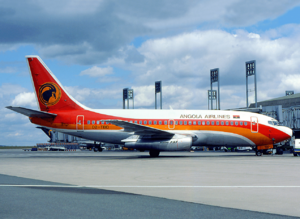
- On December 26, 2002, a Boeing 737-2M2 had a small collision in the air with a smaller Cessna 404 plane over Namibia. The Boeing plane had minor damage but continued its flight safely. Everyone on both planes survived without harm.
- On May 15, 1979, a Lockheed L-100-20 Hercules crashed while landing.
- On November 4, 1980, a Boeing 737-2M2C landed too short of the runway, slid, and caught fire. No one died, but the plane was too damaged to be used again.
- On February 9, 1984, a Boeing 737-2M2 had hydraulic problems and overran the runway during an emergency landing.
- On January 8, 1988, a Yakovlev Yak-40K went off the runway after landing.
- On February 8, 1988, a Boeing 707-349C hit an antenna while landing, damaging its hydraulic and control lines, and then went off the runway.
- On February 20, 1992, a Boeing 707-349C had a problem with its nose landing gear while moving on the ground.
See also
 In Spanish: TAAG Angola Airlines para niños
In Spanish: TAAG Angola Airlines para niños
- Airlines of Africa
- Transport in Angola


